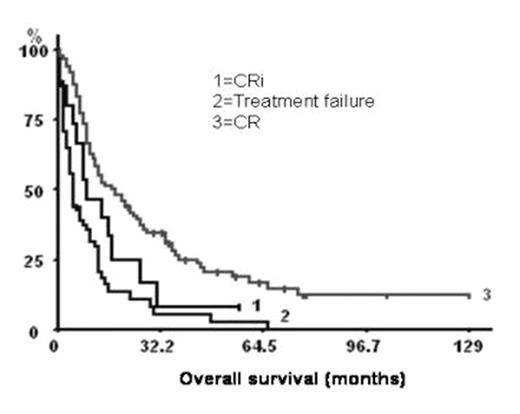Abstract
New international recommendations of response for treatment of acute myeloid leukemia (AML) include morphologic complete remission with incomplete blood count recovery (CRi). This response criteria was defined following evaluation of new drugs used for the treatment of AML in first relapse (
Sievers et al., JCO 2001;19:3244–3254
). The objective of our study was to determine the outcome of elderly patients with newly diagnosed AML achieving CRi. Between 1995 and 2006, 240 patients aged 65 years or older with previously untreated acute non promyelocytic leukemia received a conventional anthracycline and cytarabine induction chemotherapy at a single institution. Median age was 71 years (range, 65–85). One hundred and nineteen patients achieved a complete response (CR) (50%), 15 patients achieved CRi (6%), 69 patients had persisting leukemia (29%), and 37 died during remission induction therapy (15%). Patients who reached a CR or CRi after 1 or 2 cycles of induction chemotherapy proceeded to consolidation. Only 9 patients in CRi received this consolidation chemotherapy course (60%) and none had intensification (intermediate-dose cytarabine and/or autologous stem cell transplantation) whereas for patients achieving CR, 88% (n=104) and 69% (n=82) had consolidation and intensification, respectively (p=0,01 and p=0,03). The median overall survival (OS) was respectively 9 and 18 months for patients in CRi and CR (p=0,08). OS was significantly lower for patients in CRi younger than 70 years (5 versus 17 months for CR, p=0,02). By landmark analysis, there was no difference in OS between patients in CRi and a group of 67 patients with induction failure surviving at less 40 days (p=0,14). Disease-free survival (DFS) and remission duration were not significantly different between patients in CRi and CR overall (5 and 8 months, and 5 and 7 months, respectively), but we found a difference for patients younger than 70 years (p=0,004 and p=0,009 for DFS and remission duration, respectively). There was significantly more multilineage dysplasia in patients achieving CRi (8 versus 33, p=0,009) and platelet count at diagnosis were lower (44 G/L versus 82 G/L). Cytogenetic did not differ between the two groups. Our results show that the outcome of elderly patients who achieved CRi is inferior to patients in CR, especially for patients younger than 70 years. Although this response criteria seems to indicate activity, we were not able to found a difference with patients who did not achieve CR. This result will be revaluated in a larger study. Our data also suggest that patients with CRi have different initial disease characteristics.Author notes
Disclosure: No relevant conflicts of interest to declare.
2007, The American Society of Hematology
2007


This feature is available to Subscribers Only
Sign In or Create an Account Close Modal